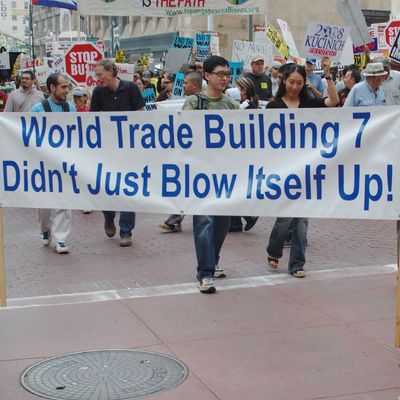
Chapman University regularly publishes its Survey of American Fears (which Science of Us covered last year), which is exactly what it sounds like: a survey running down things Americans are scared of at the moment, based on the university’s polling. This time around, Chapman also asked about ten alleged government cover-ups. “In the most striking result,” Jesse Walker notes in Reason, “25 percent of the respondents agreed—and another 7.5 percent strongly agreed—that the ‘government is concealing what they [sic] know about the North Dakota Crash.’”
But here’s the thing:
[T]he pollsters had never actually heard any conspiracy theories about a “North Dakota Crash”; they threw that in to see how people would respond to a vaguely ominous-sounding episode that they invented. Yet enough people said agree to make it the sixth most popular theory in the poll: It finished behind the notions that the government is concealing information about 9/11, the JFK assassination, aliens, global warming, or plans for a one-world government, but it was more popular than the ideas of a birther, AIDS, Scalia, or moon landing cover-up. You’ll have to guess for yourself how many of those North Dakota Crash truthers were trolling the pollsters, how many simply figure the government habitually conceals information about everything, how many were thinking about some other crash, and how many were just getting excited in the heat of the moment.
So pollsters were able to conjure a nonexistent conspiracy theory out of thin air and get a third of a sample of survey respondents to “believe” in it. Now, saying Sure, whatever, could be to a pollster is a pretty thin form of belief, but I think that’s actually the important takeaway here: It doesn’t take much to get people to kinda believe in a conspiracy theory — and that in itself is a major driver of how conspiracy theories spread these days.
At the moment, we’re immersed in something of a crisis involving misinformation, particularly of the political variety, online. It seems to be spreading faster than ever before, and doing more damage than ever before. But how many of the people who share a given conspiracy actually believe it, in the same sense that I believe the computer in front of me actually exists? Maybe we put too much weight on that question of How could someone actually believe that?! Maybe the more interesting question is the threshold at which someone believes something enough, in that Sure, whatever, could be way, to share it, increasing the odds that it will go viral.
The Chapman poll was a random sample. The online networks through which conspiracy theories spread are anything but — rather, they’re composed of ideologically like-minded people already inclined to believe, at least a little, the sorts of things that will be posted wherever they hang out. Let’s say you are convinced Hillary Clinton is the devil, and a few times a day, at work, you check the Patriot Eagle America First Muckraker News Network, or whatever, where people are constantly posting new conspiracy theories. If the important question is how far a given conspiracy theory spreads, then what matters isn’t whether you truly, deep-down in your heart, believe Clinton is a lizard person — rather, what matters is whether the rumor feels truthy enough for you to share it, which is a very low-cost, low-consequence act. You’re not putting anything on the line. The logic is similar with the Chapman survey: Do you believe this made-up thing? Sure, whatever, could be. It’s easy to tell the pollster you do, and there’s no downside.
But online, once enough people take a Sure, whatever, could be approach to a rumor because it feels truthy to them, it will spread, big-time, and will also find its way to enthusiastic true believers who really do believe it, and who will work overtime to “investigate it” (always finding evidence to support it, of course) and spread it, and sometimes these people will do real tangible harm, as in the case of Sandy Hook “hoax” obsessives. In other words, you could have a community of, say, 1,000,000 people who appear to “believe in” a conspiracy theory, in the sense that they liked or shared or commented positively on it, though most of them fall in the Sure, whatever, could be category. It doesn’t matter: The conspiracy theory will still spread far and wide, and will still do a lot of damage.
Yet another reason it is really, really hard to fight conspiracy theories.




